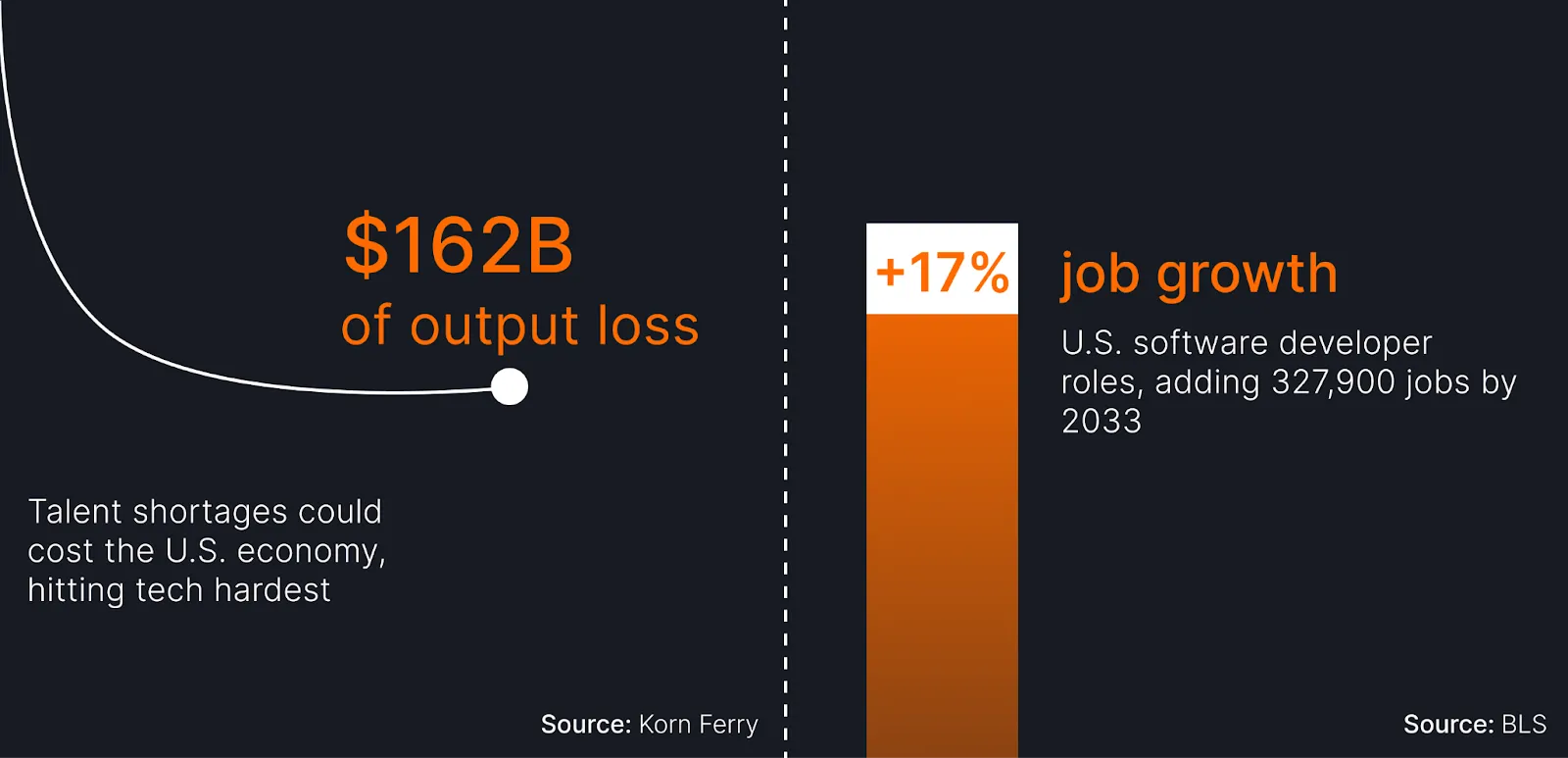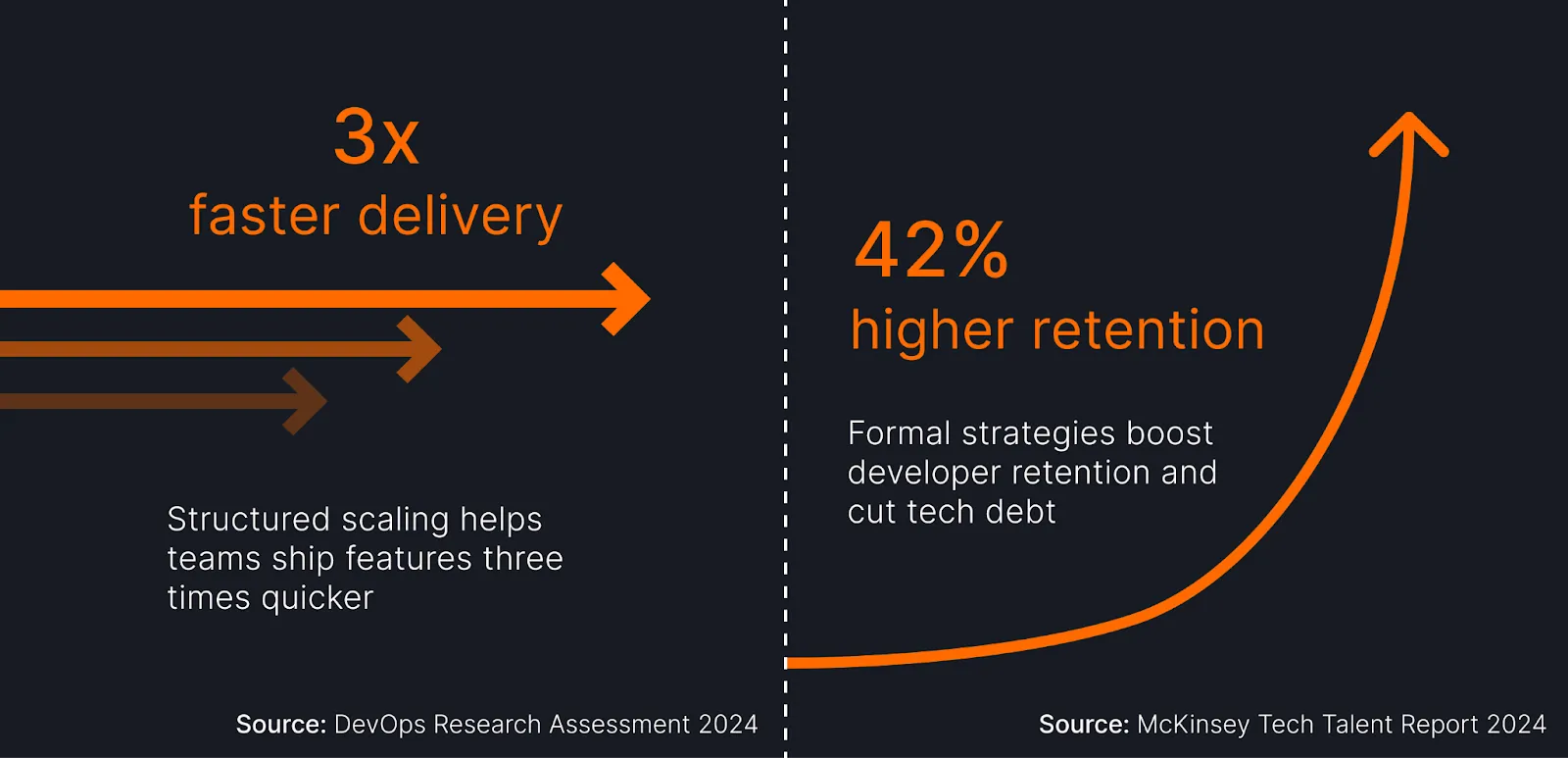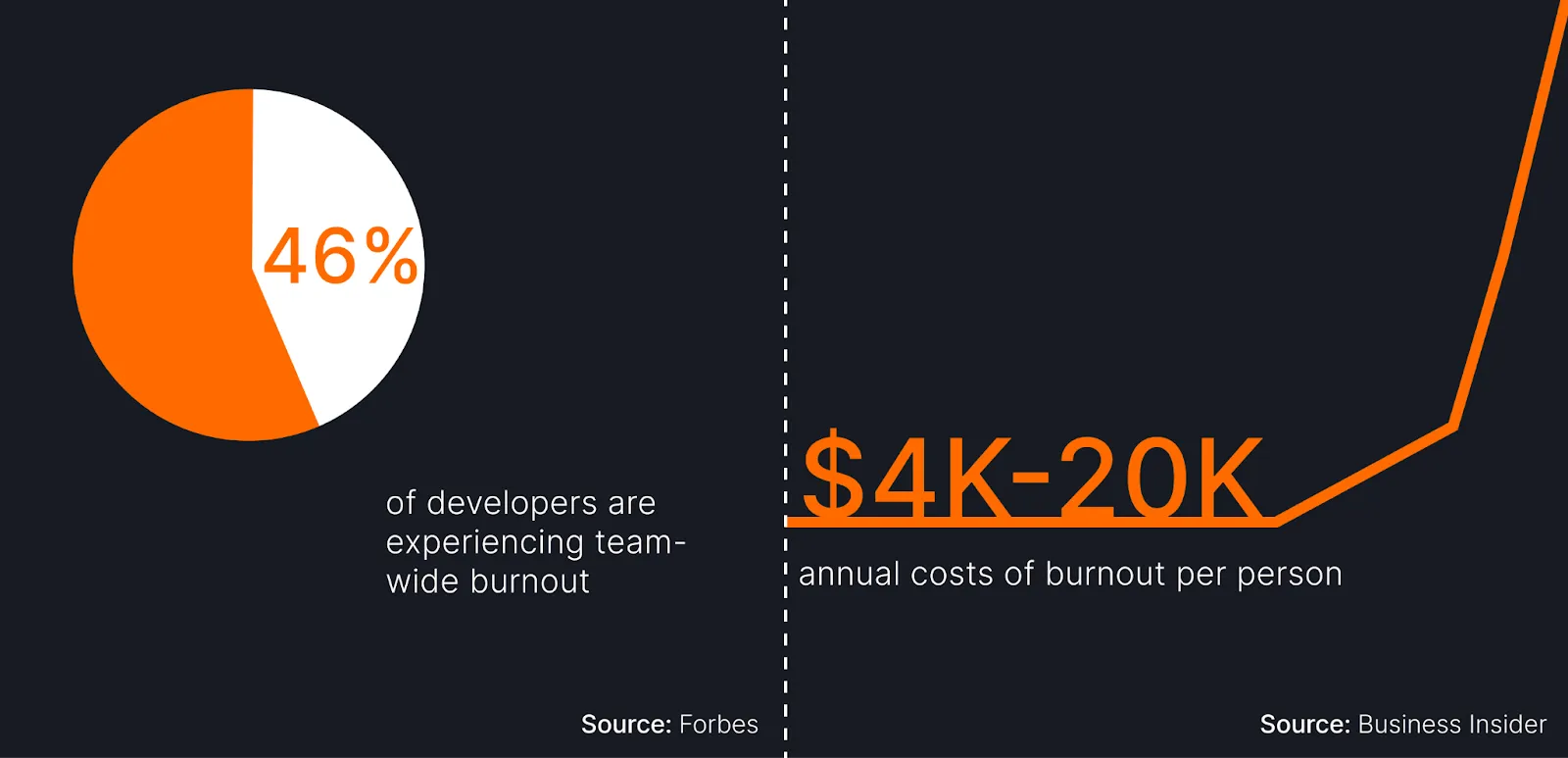Scaling Software Development Teams: Best Practices & Strategies

What Does Scaling Your Development Team Really Mean?
Shipping faster sounds great – until your roadmap starts outpacing your engineering team. And with the global tech talent shortage worsening each year, scaling isn’t just a to-do. It’s a competitive edge.
By 2030, the global talent shortage could reach 85 million workers, leading to approximately $8.5 trillion in unrealized annual revenue. In the U.S. alone, this shortage may result in a $162 billion loss in output, particularly impacting the technology sector (Korn Ferry).
Software developer employment is projected to grow 17% from 2023 to 2033 in the U.S. – much faster than the average for all occupations – adding approximately 327,900 new jobs over the decade (U.S. Bureau of Labor Statistics). This surge in demand for development services intensifies the competition for top engineering talent.

At Genius Match, we’ve spent decades helping companies, from startups to enterprise, in scaling development teams with precision. The teams that win aren’t always the biggest, but they’re always built with intent: skilled, synced, and ready to move when the product demands it.
Why Scaling Your Development Team Is Crucial for Growth
There comes a point when your product has legs, but your engineering team can’t keep up with the sprint. That’s when cracks start to show: missed deadlines, delayed features, and frustrated customers.
Scaling your development team isn’t a “someday” task. It’s essential. Do it right, and you lay the groundwork for growth that actually works. Your company is faster on its feet, quicker to adapt, and better equipped to deliver what your users and investors are asking for without the stress and scramble.
In fact, teams that implement structured scaling strategies deliver features up to three times faster than those without such frameworks (DevOps Research Assessment 2024). This acceleration is achieved by distributing workloads more effectively, addressing skill gaps, and reducing bottlenecks that typically slow down smaller, overloaded teams.
Another McKinsey Tech Talent Report found that organizations with formalized scaling strategies experience 42% higher developer retention rates and significantly less technical debt accumulation (McKinsey). This leads to fewer missed deadlines and higher overall product quality, as larger teams can dedicate resources not only to new features but also to maintenance, bug fixes, and quality assurance.

The Business Value of Strategically Scaling Software Development Teams
Scaling your development team pushes your entire product engine forward. When your company has the right team members in the right roles, new features ship faster, bugs don’t linger, and innovation doesn’t stall out your roadmap.
It also makes cross-team collaboration easier. Clear roles and a smart structure give product and engineering teams space to focus on what moves the needle. For leadership, that means fewer surprises, better predictability, and work that maps cleanly to real business impact.
Recent studies show that, after scaling your development team successfully, you might realize results such as delivering software 2.4 times faster and experience 60% fewer critical production incidents (McKinsey).
Signs You Need to Scale Your Development Team

Most business leaders, and even many engineering leaders, recognize the need to scale their development team only when problems become hard to ignore. You may notice product roadmaps slipping, quality taking a hit, or your top engineers stretched too thin across critical projects. If your backlog keeps growing despite a hardworking team, it’s likely time to expand.
Other red flags include missed release deadlines, team members overloaded with non-core tasks, or frequent context-switching that erodes productivity. In high-growth settings, even a short delay in the hiring process can cascade into months of lost progress. Proactively scaling the software development services team helps you avoid these stalls and stay ahead of demand.
The Real Risks of Growing Without a Plan
Scaling your development team reactively or without a clear plan can set you back more than not scaling at all. The pressure to deliver “faster” often leads to rushed decisions and a drop in code quality that slows everything down later. But that’s not the only issue…
Onboarding chaos and communication gaps
When your company brings in new team members without a defined hiring process, the results are messy. Onboarding becomes inconsistent and time-consuming, communication fragments across teams and locations, project management becomes erratic, and technical debt creeps in as engineers make isolated decisions. Eventually, you’ll spend more time cleaning up than moving forward.
Burnout becomes the baseline
When a lean team has to carry the weight of a growing product, morale drops and turnover rises. This churn disrupts delivery and creates even more hiring pressure. On the financial side, poor planning leads to bloated budgets, redundant roles, or over-hiring without a clear ROI.
A recent report found that 46% of developers are experiencing team-wide burnout, compared to just 34% of executives, highlighting a disconnect that threatens to increase the churn rate without strategies to scale your development team properly (Forbes).
And burnout does more than slow progress; it hits your company’s budget. Disengagement can cost teams anywhere from $4K to over $20K per person, per year, depending on role and seniority (Business Insider).

Fragile structures and lost alignment
Scaling your development team without clear onboarding and mentorship strategies might slow you down and fracture your team structure. Without a sustainable plan that streamlines onboarding, mentorship, and alignment, even talented engineers can feel lost. This erodes trust, blocks collaboration, and can stall progress across the entire product organization.
And the impact to your business is measurable. Up to 20% of employee turnover happens within the first 45 days, while 69% of employees are more likely to stay for three years when they experience great onboarding (Forbes).
Best Practices for Sustainable Team Growth
Growth should never come at the cost of control. When scaling your development team, sustainable practices are what separate thriving product orgs from those buried in tech debt, miscommunication, and hiring churn.
The following principles are rooted in experience – from scaling early-stage startups to multi-team enterprise environments. All you need is to follow these best practices and remember the //:key steps to building the tech team, as they are a proven path to long-term engineering success.
Agile & DevOps: Scaling Without Chaos
Agile is more than a buzzword. It’s a framework for managing velocity with discipline. When paired with DevOps, it creates the feedback loops, automation, and delivery pipelines needed to maintain momentum at scale.
To build a scalable delivery engine, focus on:
- Cross-functional teams owning verticals of the product.
- Short iterations with clear, achievable sprint goals.
- CI/CD pipelines that automate testing, integration, and deployment.
- Frequent retrospectives that identify and resolve process friction.
Scaling software development teams without these foundations often leads to unpredictable delivery, long QA cycles, and fire-fighting mode. Agile and DevOps don’t slow teams down but stabilize velocity so growth becomes repeatable.
Continuous Training & Upskilling
Fast-scaling organizations often underestimate the value of internal growth. But in reality, your existing team can be one of your biggest competitive advantages if you invest in their development. Upskilling isn’t a one-time benefit; it’s a long-term strategy that boosts retention, builds loyalty, and prepares your team for future challenges.
The urgency for upskilling is further emphasized by the projected economic impact of IT skill shortages. Companies in North America alone are expected to lose an estimated $5.5 trillion by 2026 due to these shortages, underscoring the critical need for continuous learning initiatives (Financial Times).
Whether it’s formal mentoring, technical deep dives, or access to relevant certifications, enabling your team to develop alongside your product gives you a level of flexibility that hiring alone can’t provide. It also helps create a culture where learning is expected, not optional – a crucial trait for teams working in rapidly shifting tech environments.
Data-Driven Decision Making in Hiring
Scaling software development teams is more about precision than speed. That’s why hiring decisions should be rooted in data from day one. Metrics like time-to-fill, ramp-up speed, and long-term performance can help you refine your process and avoid costly mis-hires.
This doesn’t mean turning your recruitment pipeline into a spreadsheet, but it does mean thinking beyond resumes and interviews.
Look at historical success:
🔸 Which roles created the most product impact?
🔸 Which channels brought in high-retention hires?
🔸 Where did onboarding fail and why?
Engineering leaders who treat hiring like a product funnel gain a serious edge. They’re able to scale smarter, not just faster, while continuously improving team composition and cohesion over time.
Case Studies: Successful Scaling in Action
These client stories illustrate how the right combination of strategy, structure, and team matching can unlock growth, accelerate delivery, and restore stability even in high-pressure environments.

Startup to Enterprise: A 5x Growth Story
A fast-growing EdTech startup building an adaptive STEM learning platform needed to scale quickly after their Series A. With strong early traction and a lean internal team, they were hitting a wall on development velocity and delivery.
By leveraging a staff augmentation model, they scaled from 6 to over 30 developers in under 6 months – without overspending or compromising their team culture.
The flexible approach allowed them to:
🔸 Bring in senior backend engineers to scale their API infrastructure.
🔸 Add QA automation specialists to shorten testing cycles.
🔸 Introduce a DevOps expert to stabilize their CI/CD pipeline.
All engineers were carefully matched based on cultural fit, communication style, and deep experience in EdTech. The outcome? A major product line launched ahead of schedule, customer NPS rose, and the team secured Series B with confidence in their roadmap and capacity.

Fixing Bottlenecks in a 50+ Developer Team
An EdTech analytics company wasn’t struggling with headcount – they had over 50 developers across multiple squads. The challenge was clarity. With murky ownership and overlapping responsibilities, output stalled despite the team’s size.
Through a combination of staff augmentation and strategic consulting, we partnered with their VP of Engineering to reset the foundation without adding more full-time hires.
Key steps included:
🔸 Restructuring squads around product outcomes rather than tech layers.
🔸 Embedding fractional product owners and defining clear KPIs.
🔸 Providing on-demand QA and DevOps support during the transition.
In just 90 days, release frequency jumped by 40%, escalations dropped sharply, and a high-churn environment was transformed into a high-performance culture – poised for sustainable growth.
Tools & Technologies to Support Scaling
Scaling your development team without the right tooling is like trying to race a Formula 1 car with bicycle tires. As your team expands, complexity grows – across workflows, deployments, and collaboration. The right technologies don’t just support growth – they enable it.
From visibility to velocity, the following tools are essential building blocks for fast-moving product teams looking to scale with control and confidence.
Project Management Tools for Large Teams
As teams grow beyond a handful of developers, tracking work with spreadsheets or ad hoc task boards becomes a liability. Clear visibility into priorities, blockers, and progress is vital for engineering, product, QA, and leadership alignment.
Platforms like Jira, Linear, or ClickUp help define ownership, maintain sprint cadence, and align multiple squads under a single roadmap. The key is not just tool adoption, but disciplined implementation – custom workflows, tagging standards, and integration with code repositories or communication platforms like Slack or MS Teams.
Used well, project management tools reduce noise, prevent work duplication, and give decision makers the clarity they need to steer confidently through growth.
Automating CI/CD for Faster Delivery
Continuous Integration and Continuous Deployment (CI/CD) are the technical spine of a scalable engineering organization. As more engineers push code, the margin for error increases along with the cost of fixing bugs after release.
CI/CD automation ensures that every code change is tested, validated, and deployed in a predictable pipeline. Tools like GitHub Actions, GitLab CI, CircleCI, and ArgoCD let you standardize deployments, reduce manual steps, and catch regressions early.
With a reliable CI/CD setup, your team can ship more often, with fewer errors, and spend less time managing environments or coordinating last-minute fixes. In a scaling context, that’s a genius move.
Monitoring Performance at Scale
As your user base grows and your team delivers more frequently, observability becomes non-negotiable. Without performance insights, even the best product features can fail in the wild, damaging user trust and undermining your business goals.
Tools like Datadog, New Relic, Grafana, and Prometheus help teams detect performance degradation, API issues, and infrastructure bottlenecks in real time. The goal is proactive issue resolution and user experience stability.
When teams grow, it’s easy to assume someone else is watching the metrics. Don’t make that mistake. Bake observability into your DevOps culture, and ensure everyone has access to actionable performance data.

Empowering EdTech Innovation with Tailored Talent Solutions
This case study showcases how Genius Match helped a leading EdTech company fast-track its digital transformation and product roadmap through tailored outstaffing solutions.

4 Key Steps to Building a Tech Team That Drives Growth
Scaling your engineering team isn’t just about hiring – it’s about hiring right. Discover the key steps to building a high-performing team that fuels innovation and growth.

How to Scale Your Engineering Department Quickly Without Compromising Quality
A strategic guide to expanding your engineering team while maintaining productivity, code quality, and team cohesion.